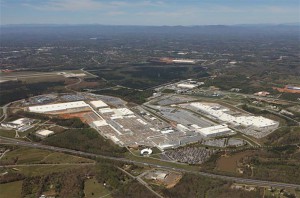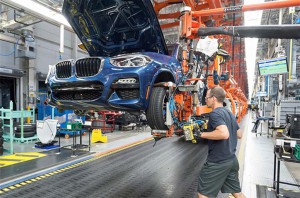BMW plans to invest another $600 million to update and expand its Spartanburg, South Carolina, assembly plant, the automaker announced Monday, while adding that the move will also create another 1,000 jobs.
The move comes barely a year after the Bavarian carmaker completed a previous, $1 billion investment in the nearly quarter century-old factory that is now the single-largest source of automotive exports from the United States to markets abroad.
The announcement comes barely a month after BMW and other German manufacturers were attacked by President Donald Trump who, in a tweet, called them “Very Bad,” while seeming not to recognize the significant number of products German companies produce in the United States.
The Spartanburg plant, which was announced 25 years ago this month, currently produces various iterations of BMW’s Sports-Activity Vehicles. That includes an all-new version of the compact X3 model unveiled last weekend. It will roll into U.S. showrooms in November, about the same time it will begin being shipped abroad.
(BMW unveils 3rd generation X3 and first-ever M-Edition. Click Here for the story.)
“It is our goal, and our commitment, to remain a strong and reliable partner for our associates, our customers, South Carolina, and the United States,” said BMW Manufacturing CEO Knudt Flor.
If the new X3 meets expectations it could mean a new production record for the Spartanburg plant – which produced a total of 411,171 vehicles in 2016. Of those, 287,700, or 70% of its total volume, were shipped to markets abroad.

BMW's Spartanburg, South Carolina, plant exports more vehicles out of the United States than any other in the country.
“Our vehicles are in high demand,” plant chief Flor said earlier this year when the final 2016 figures were released. “Customers from 140 countries around the world are eagerly awaiting our vehicles.”
Production at the plant began in 1994 with models such as the BMW 3-Series and the Z4. Today, the focus is on the BMW utility vehicle family, some models, such as the big X5, being produced only in South Carolina. Since the plant debuted, BMW said, it has assembled 3.7 million cars and crossovers for export.
(When is a 5-Series not a 5? When it’s now the BMW 6-Series Gran Turismo. Click Here for the story.)
Since it opened, BMW has spent $2.2 billion on the Spartanburg facility. The latest, $600 million investment will be completed by 2021, it said. The current workforce of 9,000 is expected to grow to 10,000 when the project is completed. BMW did not state how much production capacity will grow.
“We will keep investing in our people and in our business in the U.S.,” BMW CEO Harald Krueger said in a statement. “Therefore, I remain confident that our footprint and commitment will continue to grow not only in the great state of South Carolina, but also in the United States in the years to come.”
BMW isn’t alone among Germans – and other foreign-owned automakers – building cars in the U.S. Mercedes-Benz is second on the auto export list, relying on its plant in Vance, Alabama. And Volkswagen is ramping up its own export plans as it expands operations in Chattanooga, Tennessee. It recently completed doubling the size of the factory which will be the only global source for the new Atlas SUV.
All the major Japanese automakers – some of whom have also taken heat from Trump – have U.S. operations, many of them exporting products to various parts of the world.
(BMW outsourcing to Magna the new 5-Series sedan and EV. Click Here for the story.)
All in all, government data show U.S.-based auto plants exports $53.8 billion worth of vehicles last year, just behind Germany and Japan in terms of global auto exports. Foreign-owned brands were responsible for the majority of those vehicles.

